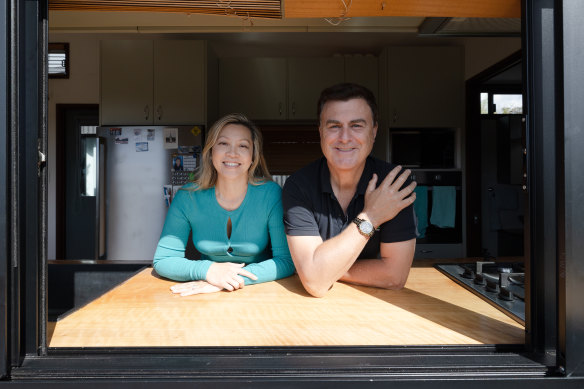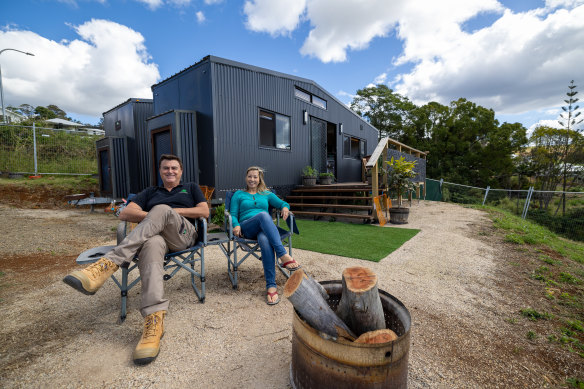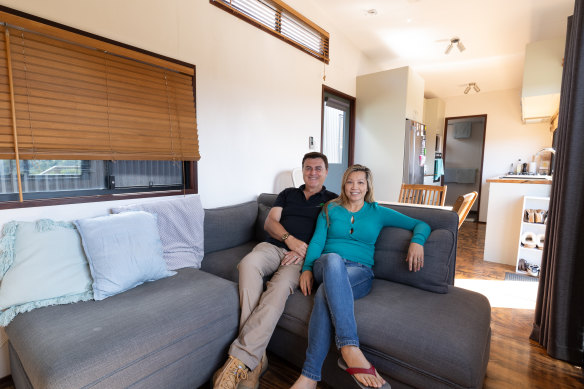This family’s tiny solution to the big mortgage stress problem
Dr Dang Nguyen and her family haven’t had a mortgage for years.
After living in a caravan for 18 months with her husband and daughter - a fun lifestyle while travelling but too small for permanent living - she designed two tiny house units that are 9.5 metres long.

Dr Dang Nguyen and Peter Wigley in their tiny home.Credit: Danielle Smith
Advocates for tiny homes believe living in intentional tiny home communities with shared facilities could be one part of the solution to the affordable housing crisis. Although no substitute for more suburban infill development or apartment blocks near transport links, it could be a piece of the puzzle for some.
Her family has been living in their tiny house in northern NSW for two and a half years. The two units cost $240,000 to build and the separation was preferred to a tiny house with an upstairs level. The design allows everyone to have their sense of space and a cosy shared living area when they are all together.
It takes very little time to clean the internal 40 square metre space, so they have more quality time to spend with each other.
“There’s less stress on the family,” said Nguyen, who, as a psychiatrist, takes stress seriously.
“A lot of issues that arise with mental health are to do with having your own space. We can’t always be with people all the time. But at the same time having connections, especially in the family between parent and child, is important,” she said.
Despite the satisfaction the family experience living in a tiny house, Nguyen says they have no choice but to go back to brick-and-mortar living because of the lack of support for this type of living.
Caravan parks have a cap on the number of nights people can stay. So families who live in tiny homes struggle to be close to schools for their children.
“Most people who live in tinies have to be out on a rural property,” she said, which can incur rental costs.

The family would like to live in a tiny home community. Credit: Danielle Smith
Nguyen says this may work for people who don’t have the responsibility of children. But for them, it is a problem not to have the ability to park their tiny home anywhere that’s close to services like schools and shopping centres.
“You have to be very far away from town. [So it’s] difficult to transport children to school.”
Nguyen’s husband is Peter Wigley, CEO of Tiny Homes Australia and NSW representative for the Australian Tiny Homes Association (ATHA). ATHA wrote to federal, state, and local administrators seeking permanent parking spaces for tiny houses.
The couple purchased a block of land and were in talks with Richmond Valley Council about establishing a tiny home community.

Less space means less to clean.Credit: Danielle Smith
“We were actually just going to fund it and do it all ourselves,” Wigley said, adding the US has an abundance of tiny home communities and Australia should head in the same direction.
The council initially said yes to a pilot program. But then when the state government changed it got put on the back burner.
Asked about the delay, a spokesperson for the NSW Land and Housing Corporation said: “Under the new government we’re exploring every option to deliver more and better homes for the people of NSW and to address the state’s housing crisis, this includes tiny homes as well as other housing solutions.”
Professor Paul Burton from Griffith University’s Cities Research Institute says the current housing situation is forcing people to reassess their priorities.
“We are in desperate times, in terms of a housing crisis, and it’s not going to ease quickly. So it’s going to take a long time and a concerted effort and tiny houses can make a contribution,” he said.
Most people living tiny do so under the radar out of fear of being moved on. As a town planner, Burton says council opposition is generally due to concerns regarding infrastructure usage such as water and sewerage, and neighbour complaints.
“If you wanted to get permission to live in a tiny house on wheels for a longer period of time, then you’d have to go through a more complicated application process. And that’s where councils get a bit twitchy,” he said.
Wigley says most people that live tiny won’t mind paying a yearly fee if they have a sense of permanency.
He refutes any suggestion that a tiny house community could become a decrepit living arrangement.
“We don’t see a lot of ghettos in tiny home communities in America, because everyone owns their own home. They have a sense of pride in that,” he said.
Nguyen added: “We’d love to be able to live in suburbia in a tiny home community. We will be mortgage-free and stress-free. And our mental health will be so much better.”